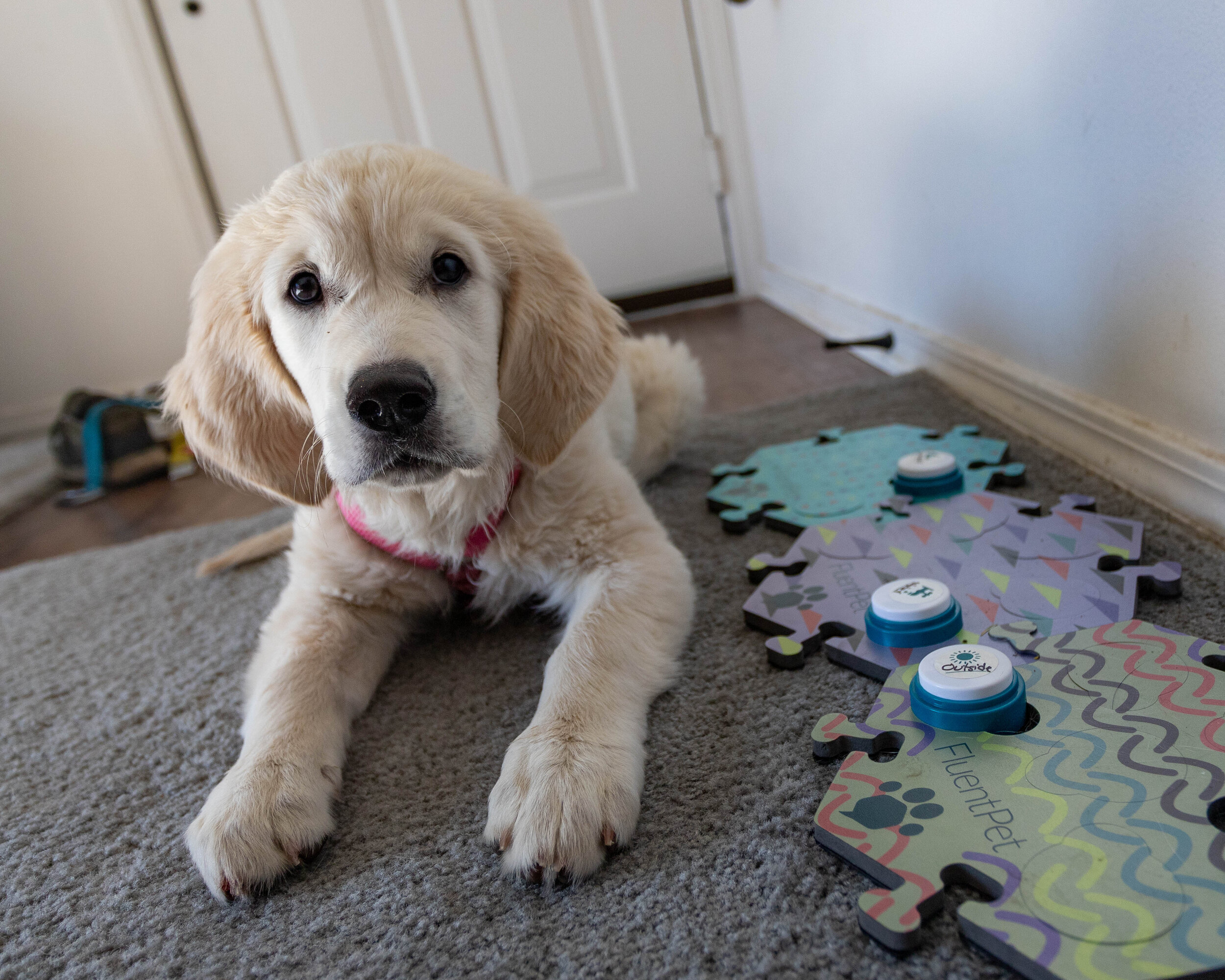Teaching My Dog to “Talk”: Why I Use an AAC Device to Give My Dogs a Voice
The following post may contain affiliate links. If you shop using these links, I may receive a small commission at no additional expense to you. I only recommend products that I genuinely love!
If your dog could speak to you, what would he say? In Starsky’s case, it wasn’t so much what he said, but how he said it: with a whole lot of sass.
Baby Ginsburg with her buttons, the day after she pressed “attention” for the first time.
I taught my dog to talk using an AAC (augmentative and alternative communication) device. While AAC devices are usually used by people who have difficulty speaking, speech pathologist Christina Hunger experimented with teaching her dog to communicate using such a device. Stella, the OG talking dog, communicates with her humans using a series of buttons. Since then, thousands of others, myself included, have replicated her experiment with their own dogs.
One of the most common questions is simply: why?
The short answer is obviously that canine AAC is fun and super cool!
The longer answer: dogs already communicate with us. Think about the last time you took your dog outside to potty. How did you know he had to go? Does he whine? Sit by the door? Paw at your arm? Bark incessantly like my puppy?! Chances are, your dog communicated to you that he needed to go to the bathroom. AAC is simply an alternative form of communication that allows your dog to give you a more specific, and therefore efficient, message.
It’s also great for your relationship with your dog. Most dogs enjoy and thrive with regular training. It works their minds and keeps them sharp. Training is also one of the quickest ways to bond with a dog, since you are working together as a team. AAC is nontraditional, but no less legitimate, dog training.
Another common question is whether canine AAC is real. There’s a lot of nuance to discuss, but my answer is a resounding definitely…maybe…probably…YES.
If “communication” is making your needs and wants known to another being, then canine AAC and talking dogs are absolutely real. Through the principles of classical conditioning, your dog learns to associate certain buttons with certain outcomes. Dogs already learn plenty of human words in the same way; Fido sits when you say “sit”, gets excited in anticipation of dinner when you ask if he is “hungry”, and runs to the door when you suggest the family goes for a “walk”. Your pup just doesn’t have the means to produce those words. Although I am not a speech pathologist or canine behaviorist, I don’t think it’s such a stretch to hypothesize that dogs could learn to use a device to produce words that communicate their desires and elicit certain reactions from their humans.
That said, Starsky does have “misfires”. In the late afternoon, he tends to get bratty and seek attention – I call these his Devil Hours! During that time, he will eagerly press all of his buttons to get any sort of attention from me. This is when I take a lot of my Tik Tok videos because it’s the time of day he is most likely to “talk back”. This pattern of late afternoon misfires does raise a few questions for me:
1. Does Starsky truly understand the different buttons? I tend to think he does because many of his button presses outside of his Devil Hours are situationally appropriate. For example, he often presses his “attention” button and then walks right over to me and shoves his booty in my face, begging for butt scritches!
2. Does Starsky just not have enough buttons to express himself? He is definitely limited in what he can say and I think he would especially benefit from a “frustrated” button for those Devil Hours. Right now, I’m hesitant to add any more buttons because I don’t think his level of comprehension of his current ones is high enough to start adding more. Plus I don’t want to confuse Ginsburg by adding more buttons when she has only just figured out her first one!
3. Am I just not listening to his needs? Yup, I am definitely falling down on the dog mom job here. Starsky gets agitated at the same time every day. Although I am working remotely due to COVID-19, my job is still a 9-5 and I am expected to be available during business hours. I am often hesitant to take a break, but perhaps I should give him a sniffari (long leash walk where he is allowed to sniff everything) around 3pm each day to work his brain and get his muscles moving. He would would probably be less frustrated, and less likely to incessantly push his buttons (and mine!).
And then there’s the question of whether any of this is natural. Canine AAC is certainly novel. Pioneered by Stella and popularized by Bunny, AAC is a pretty new dog training experiment. But something that is novel can also be natural. Dogs are built to learn, work, and use their brains. They already naturally develop ways to communicate their needs to us. Therefore, training them to use buttons is not unnatural; rather, it actually harnesses their innate abilities to create a far more effective communication style.
I’m so excited to continue experimenting with AAC with my own dogs. As an enthusiastic dog mom, there’s nothing more fulfilling than watching my dogs’ brains work to puzzle through new concepts – especially when they are so satisfied with themselves afterward!
Want to get started with AAC for your dog? Check out my favorite canine AAC buttons!


